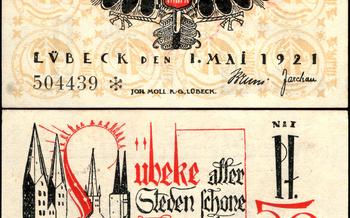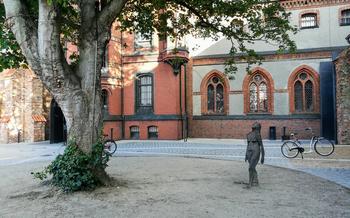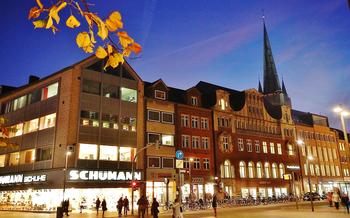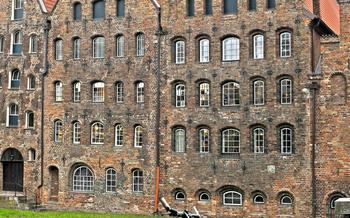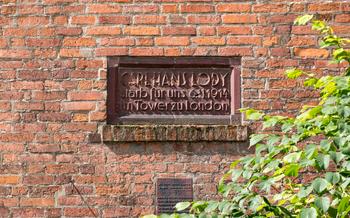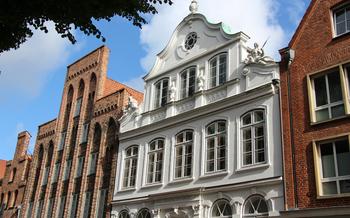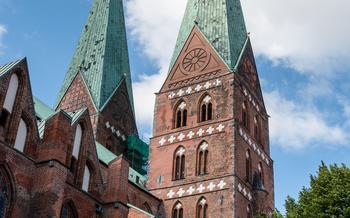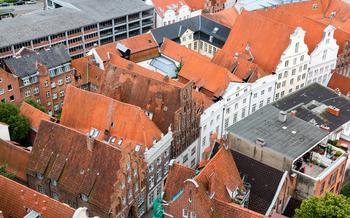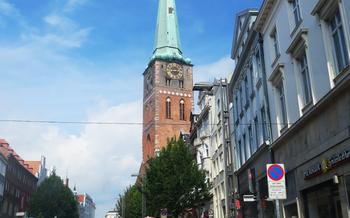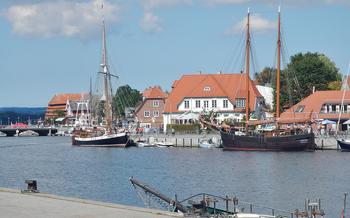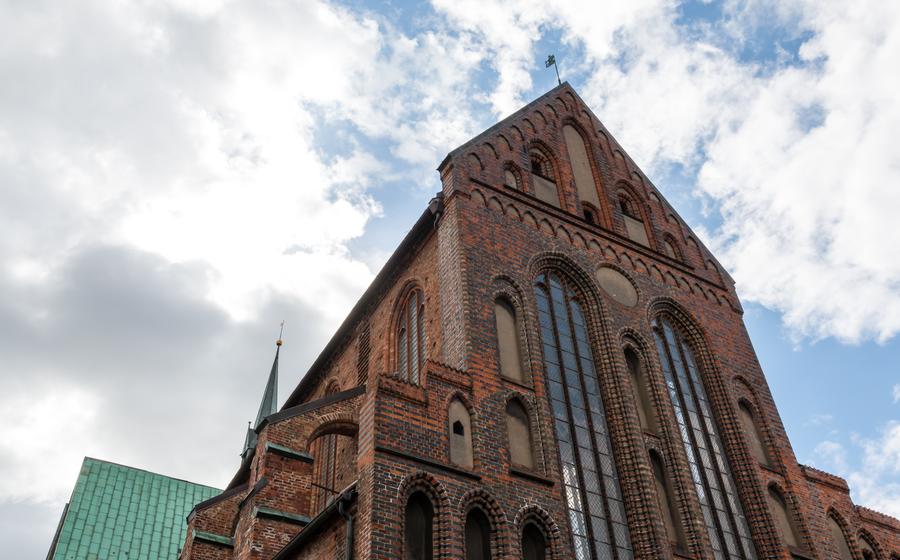
Katharinenkirche (St. Catherine's Church)
- A Gothic Masterpiece in the Heart of Lübeck
- Lübeck's Symbol of Maritime Power
- Exploring the Church's Interior
- The Tower of St. Catherine's
- The Church's Rich History
- Lübeck's Gothic Quarter
- Attending Services and Events
- The Legacy of St. Catherine
- Restoration and Preservation
- A Place of Reflection and Inspiration
- Visiting the Church
- The Church in Literature and Art
- Unique Features and Curiosities
- The People Behind the Church
- Insider Tip: Unveiling the Hidden Beauty of the Katharinenkirche
A Gothic Masterpiece in the Heart of Lübeck
In the heart of the historic city of Lübeck, nestled among the charming streets and canals, stands a majestic architectural masterpiece - St. Catherine's Church. This awe-inspiring Gothic edifice, with its soaring spires and intricate details, has stood as a symbol of faith, history, and maritime power for centuries.
The church's exterior is a testament to the skill and artistry of its medieval builders. The intricate carvings adorning the facade, the graceful flying buttresses supporting the walls, and the delicate tracery of the windows create a symphony of stone that captivates the eye. The towering spires, reaching towards the heavens, seem to pierce the clouds and draw the gaze of all who behold them.
Stepping inside St. Catherine's, one is immediately struck by the grandeur and luminosity of the interior. The nave, with its vaulted ceiling supported by slender columns, creates a sense of spaciousness and awe. The intricate stained glass windows, depicting biblical scenes and the lives of saints, cast a kaleidoscope of colors onto the polished stone floor, creating an ethereal atmosphere.
The church's interior is adorned with a wealth of artworks and sculptures, each telling a story from the rich history of Lübeck and its connection to the sea. The most striking among them is the magnificent altarpiece, a masterpiece of woodcarving that depicts the life of St. Catherine, the church's patron saint. The intricate details and lifelike expressions of the figures bring the biblical narratives to life, inviting visitors to contemplate the stories of faith and sacrifice.
Lübeck's Symbol of Maritime Power
St. Catherine's Church is inextricably linked to the Hanseatic League, a powerful alliance of trading cities that dominated maritime trade in Northern Europe during the Middle Ages. Lübeck, as one of the league's leading members, played a crucial role in this network, and St. Catherine's Church served as a symbol of the city's maritime prowess.
The church's patron saint, St. Catherine of Alexandria, was a popular figure among merchants and sailors. Her attributes, including the wheel and the sword, symbolized protection and victory, making her a fitting patron for those who ventured out to sea. Many Lübeck merchants and seafarers sought her blessings before embarking on their journeys, praying for safe passage and successful ventures.
Stories abound of Lübeck's seafaring merchants who attributed their success to St. Catherine's intercession. One tale tells of a merchant named Johann Wittenborg, who survived a fierce storm at sea after praying to St. Catherine. In gratitude, he donated a magnificent stained glass window to the church, depicting St. Catherine surrounded by ships in distress.
The church's interior is adorned with maritime motifs, reflecting the city's seafaring heritage. intricate carvings of ships and sea creatures decorate the pews, while paintings and sculptures depict scenes of trade and commerce. The massive organ, with its majestic sound, evokes the roar of the sea, adding to the church's maritime atmosphere.
Exploring the Church's Interior
Inside St. Catherine's Church, visitors are met with a breathtaking expanse of Gothic grandeur. The nave, supported by slender columns and ribbed vaults, soars upwards, creating a sense of awe and inspiration. The walls are adorned with intricate carvings and decorative elements, telling stories from the Bible and the lives of saints.
One of the most captivating features of the church's interior is its stained glass windows. These colorful masterpieces depict scenes from the life of Jesus, the Virgin Mary, and various saints. The light filtering through the windows casts a warm, ethereal glow on the interior, creating a truly magical atmosphere.
Notable artworks and sculptures are scattered throughout the church, each with its own unique story to tell. The bronze baptismal font, crafted in the 14th century, is a masterpiece of Gothic art. The intricate carvings on the font depict scenes from the life of John the Baptist, and the font itself is a symbol of the church's baptismal tradition.
Another highlight of the church's interior is its organ, built in the 19th century. With its impressive size and beautiful sound, the organ is a testament to the musical heritage of St. Catherine's. Regular concerts and recitals are held in the church, allowing visitors to experience the organ's majestic sound and appreciate the church's rich musical tradition.
The Tower of St. Catherine's
The slender tower of St. Catherine's Church, with its distinctive copper-clad spire, is a striking landmark that dominates Lübeck's skyline. Standing at around 107 meters (351 feet), it is the second-tallest church tower in the city, after the Marienkirche. The tower's observation deck offers breathtaking panoramic views of Lübeck and its surroundings, making it a popular attraction for visitors. On a clear day, you can see as far as the Baltic Sea to the north and the Holstein Uplands to the west.
The tower's construction was a remarkable feat of engineering for its time. Begun in the late 14th century, it took several decades to complete. The tower's height and elaborate design required innovative techniques to ensure its stability. The massive foundation, built on a layer of wooden piles, supports the tower's weight, while the use of flying buttresses and vaulted ceilings distributes the load evenly. The tower's exterior is adorned with intricate carvings and decorative elements, reflecting the Gothic style popular during its construction.
Climbing the tower's 225 steps is a rewarding experience, offering a unique perspective on Lübeck's architectural treasures. The tower's narrow spiral staircase leads visitors through the centuries, passing by the massive bells and the intricate clockwork mechanisms. Along the way, you can admire the tower's interior, with its vaulted ceilings and exposed beams.
Once you reach the observation deck, you are greeted by a breathtaking panorama of Lübeck and its surroundings. The city's red-tiled roofs, spires, and gabled houses stretch out before you, surrounded by the lush green of the surrounding countryside. On the horizon, you can spot the blue waters of the Baltic Sea and the distant hills of Holstein. The tower is open to visitors during the summer months, and guided tours are available for those who want to learn more about the tower's history and construction.
The Church's Rich History
The founding of St. Catherine's Church dates back to the 13th century, when Lübeck was a thriving city within the Hanseatic League. The church served as a spiritual and communal center for the city's merchants and seafarers. Throughout its history, St. Catherine's has witnessed numerous significant events and milestones.
In the 16th century, the Reformation swept through Lübeck, and St. Catherine's became a Lutheran church. This marked a significant change in the church's religious practices and traditions. Despite the Reformation, the church retained its importance as a civic and cultural landmark.
Over the centuries, St. Catherine's has undergone several renovations and expansions. The most notable addition was the construction of the church's iconic tower in the 14th century. The tower became a prominent landmark and a symbol of Lübeck's maritime power.
St. Catherine's Church has played a crucial role in Lübeck's cultural and religious life. It has hosted numerous concerts, exhibitions, and religious services. The church's impressive acoustics have made it a popular venue for musical performances.
Today, St. Catherine's stands as a testament to Lübeck's rich history and its enduring faith. The church continues to be an active place of worship and a popular tourist attraction, drawing visitors from around the world.
Lübeck's Gothic Quarter
St. Catherine's Church stands proudly at the heart of Lübeck's enchanting Gothic Quarter, a district brimming with architectural treasures and historic charm. Wander through the cobbled streets and marvel at the intricate facades of medieval buildings, each telling a story of the city's rich past.
In the shadow of St. Catherine's, you'll find the majestic Town Hall, a masterpiece of Gothic architecture that once served as the seat of Lübeck's powerful city council. Its ornate facade, adorned with intricate carvings and sculptures, reflects the city's wealth and influence during the Hanseatic League era.
Another notable landmark is the Heiligen-Geist-Hospital, a former hospital that now houses a museum dedicated to the history of Lübeck's social welfare institutions. Step inside to learn about the city's compassionate care for the sick and needy throughout the centuries.
As you explore the Gothic Quarter, don't miss the opportunity to visit the Buddenbrookhaus, a former merchant's house that has been transformed into a museum dedicated to the life and works of Thomas Mann, Lübeck's Nobel Prize-winning author. Immerse yourself in the world of the Buddenbrook family and gain insights into the social and cultural history of Lübeck during the late 19th century.
Lübeck's Altstadt, with its harmonious blend of Gothic architecture and modern life, offers a unique and captivating experience. Take your time to wander through its charming streets, soak in the atmosphere, and discover the hidden gems that await you around every corner.
Attending Services and Events
St. Catherine's Church is an active place of worship, with regular services held throughout the week and on Sundays. Attending a service here is a unique opportunity to experience the church's sacred atmosphere and witness the vibrant community of believers who gather within its walls.
Services are conducted in German, but visitors are welcome to join and follow along with the provided English-language service booklets. The church's acoustics are renowned, making it a special experience to listen to the choir and organ music that accompany the services.
In addition to regular services, St. Catherine's also hosts special events and concerts throughout the year. These events provide a platform for talented musicians and performers to showcase their work, while also raising funds for the church's preservation and restoration efforts.
Visitors who wish to attend a service or event are advised to check the church's website or contact the parish office for more information. It's important to arrive a few minutes early to find a seat and settle in before the service begins.
During services, visitors are expected to be respectful and follow the local customs and etiquette. This includes standing and sitting when appropriate and refraining from talking or using electronic devices during the service.
Attending a service or event at St. Catherine's is a wonderful way to immerse oneself in the church's rich history, appreciate its stunning architecture, and connect with the local community. It's an experience that offers both spiritual and cultural enrichment for visitors from all over the world.
The Legacy of St. Catherine
St. Catherine of Alexandria, the patron saint of merchants and education, is a figure of great significance in the history and symbolism of St. Catherine's Church. According to legend, Catherine was a young woman from Alexandria, Egypt, who lived in the 4th century. She was renowned for her intelligence, eloquence, and unwavering faith. When the Roman emperor Maxentius attempted to force her to renounce her Christian beliefs, she boldly refused and engaged in a philosophical debate with him. Catherine's wisdom and eloquence impressed even the emperor's most learned scholars, but her steadfastness in her faith ultimately led to her martyrdom.
Catherine's attributes, which often appear in art and architecture, symbolize her virtues and her triumph over adversity. The wheel, a symbol of her martyrdom, is often depicted with broken spokes, representing her victory over the emperor's attempts to break her spirit. The sword represents her unwavering faith, which ultimately led to her execution. The book symbolizes her love of learning and her role as a patron saint of education.
The legacy of St. Catherine continues to inspire and guide the people of Lübeck. Her story of courage, faith, and intellectual prowess serves as a reminder of the importance of standing up for one's beliefs, even in the face of adversity. Her patronage of merchants and education reflects the deep connection between St. Catherine's Church and the city's maritime and intellectual heritage.
Restoration and Preservation
St. Catherine's Church, with its towering spires and intricate Gothic details, stands as a testament to the enduring spirit of Lübeck. However, preserving this architectural masterpiece is an ongoing challenge, requiring meticulous care and unwavering dedication.
The ravages of time, harsh weather conditions, and the natural wear and tear of centuries have left their mark on the church's exterior and interior. Maintaining the structural integrity of the building while preserving its historical authenticity is a delicate balancing act.
Skilled craftsmen, armed with their expertise and a deep reverence for the church's legacy, meticulously restore every weathered stone, intricate carving, and delicate stained glass window. Their work is painstaking and time-consuming, requiring specialized techniques and an intimate understanding of the church's unique characteristics.
The church community plays a vital role in safeguarding St. Catherine's heritage. Through fundraising initiatives, educational programs, and volunteer efforts, they actively contribute to the church's preservation. Their passion and commitment ensure that future generations can continue to marvel at this architectural treasure.
The preservation of St. Catherine's is not merely a matter of bricks and mortar; it is about preserving the soul of Lübeck. It is a testament to the city's rich history, its cultural significance, and its enduring connection to the past. Every effort to restore and maintain this architectural marvel is an investment in Lübeck's legacy and a celebration of its architectural treasures.
A Place of Reflection and Inspiration
St. Catherine's Church exudes a serene and contemplative atmosphere, inviting visitors to find solace and inspiration within its sacred walls. Throughout its history, countless individuals have sought refuge and comfort in this hallowed space. The church's architectural grandeur, intricate artwork, and rich symbolism create an environment conducive to reflection and spiritual connection.
Stories abound of those who have found solace and renewal within St. Catherine's. Pilgrims seeking guidance or relief from life's burdens have been drawn to the church for centuries. Its tranquil ambiance provides a sanctuary for weary souls, a place to pause and reconnect with their inner selves.
The church's significance as a symbol of hope and resilience is deeply intertwined with the history of Lübeck. Having withstood wars, fires, and the passage of time, St. Catherine's stands as a testament to the enduring spirit of the city. Its resilience serves as a reminder that even in the face of adversity, hope can prevail.
For visitors seeking a spiritual and contemplative experience, St. Catherine's offers a sanctuary for reflection and inspiration. Whether through attending a service, admiring the intricate artwork, or simply sitting in quiet contemplation, the church invites all who enter to find solace and a renewed sense of purpose.
Visiting the Church
Practical Information for an Enriching Visit:
Planning a visit to St. Catherine's Church is a must when exploring Lübeck. The church is open to the public daily, offering ample opportunities to admire its grandeur. Visitors can wander through the nave, marvel at the intricate details of the stained glass windows, and take in the serene atmosphere of this sacred space. Guided tours are available for those seeking a deeper understanding of the church's history and architecture. These tours provide insights into the symbolism and stories behind the church's design, making for a truly immersive experience.
Admission to the church is free, allowing visitors to enjoy its beauty without financial constraints. Photography is permitted inside the church, so visitors can capture their favorite moments and share their experiences with others. For those with limited mobility, the church is wheelchair accessible, ensuring that everyone can partake in the wonders of St. Catherine's.
To make the most of your visit, plan your itinerary carefully. The church's opening hours vary throughout the year, so it's advisable to check the official website or consult local tourist information centers for up-to-date information. If you're interested in attending a church service or concert, be sure to check the church's calendar of events to avoid any disappointment.
Combining a visit to St. Catherine's with other attractions in Lübeck is easy and rewarding. The church is located in the heart of the city's Altstadt, within walking distance of other notable landmarks such as the Town Hall, the Buddenbrookhaus, and the Museum of Art and Cultural History. By exploring these attractions together, visitors can immerse themselves in Lübeck's rich history and vibrant cultural heritage.
The Church in Literature and Art
St. Catherine's Church has been a muse to artists and writers for centuries. Its imposing presence and rich history have inspired countless works of literature, poetry, and music.
In the realm of literature, the church features prominently in Thomas Mann's epic novel "Buddenbrooks," a sweeping saga of a wealthy merchant family in Lübeck. The church serves as a backdrop for significant events in the novel, reflecting the deep connection between the city's maritime heritage and its religious life.
Poets have also found inspiration within St. Catherine's hallowed walls. Günter Grass, a Nobel laureate and Lübeck native, penned several poems evoking the church's grandeur and its role in shaping the city's identity. His poem "St. Catherine's Church in Lübeck" captures the church's timeless beauty and its ability to transport visitors to another era.
Music has played a vital role in St. Catherine's history, and its magnificent organ has been a source of inspiration for composers. Dietrich Buxtehude, a renowned organist and composer of the Baroque era, served as organist at St. Catherine's for over four decades. His compositions, often performed within the church's walls, showcased the instrument's versatility and power.
The church's distinctive silhouette has also been immortalized in paintings and drawings. Romantic artist Caspar David Friedrich depicted the church in his painting "Lübeck Cathedral," capturing its Gothic splendor against a dramatic sky. Other artists, like Eduard Gaertner and Carl Julius Milde, have created beautiful watercolors and sketches of the church, each capturing its unique charm and character.
Through these artistic expressions, St. Catherine's Church has become an enduring symbol of Lübeck's rich cultural heritage. It stands as a testament to the power of architecture to inspire and captivate the human imagination.
Unique Features and Curiosities
St. Catherine's Church holds many hidden secrets and unique features that add to its charm and mystery. One intriguing aspect is the presence of a small, wooden door concealed within the church's massive walls. This door, known as the "Devil's Door," is said to have been created during the church's construction when a mischievous devil wagered with the builders that he could complete the entire church in a single night. As the story goes, the devil worked tirelessly, but as dawn approached, he realized he would not finish in time. In desperation, he attempted to sneak into the church through the small door, but the door slammed shut, trapping him inside. To this day, visitors can still spot the Devil's Door, adorned with intricate carvings, as a reminder of this legendary tale.
Another unique feature of St. Catherine's Church is its impressive astronomical clock. Created in the 16th century, this intricate clock is a marvel of engineering and artistry. It features moving figures that depict the passage of time, including the sun, moon, and stars. Visitors can marvel at the clock's intricate details, which include representations of the zodiac signs and scenes from the Bible. The clock is a testament to the ingenuity and craftsmanship of the artisans who created it and continues to captivate visitors with its precision and beauty.
The People Behind the Church
St. Catherine's Church is not merely a magnificent architectural marvel; it is a living, breathing testament to the dedication and passion of countless individuals who have played a pivotal role in its history. Over the centuries, a diverse cast of characters has contributed to the church's legacy, leaving an indelible mark on its story.
From the visionary architects and builders who brought the church to life to the devoted clergy who have guided its spiritual growth, each person involved in St. Catherine's has played a crucial part in its journey. The church's staff, from the organists who fill the air with celestial melodies to the custodians who meticulously maintain its sacred spaces, work tirelessly to ensure that St. Catherine's continues to thrive.
Volunteers from the local community also play a vital role, generously giving their time and energy to preserve and promote the church's heritage. Their unwavering commitment is a testament to the deep connection that Lübeck's people feel with this iconic landmark.
One such individual is Frau Schmidt, a lifelong resident of Lübeck who has been volunteering at St. Catherine's for over 20 years. With a twinkle in her eye and a wealth of knowledge about the church's history, Frau Schmidt loves sharing her passion with visitors. Her enthusiasm is contagious, and her dedication is a true inspiration.
The people of Lübeck are the heart and soul of St. Catherine's Church. Their unwavering support and tireless efforts ensure that this architectural masterpiece continues to stand as a beacon of faith, history, and community spirit.
Insider Tip: Unveiling the Hidden Beauty of the Katharinenkirche
As you explore the Katharinenkirche, keep an eye out for the "Totentanz" (Dance of Death) fresco, a hidden gem tucked away in the church's northern chapel. This remarkable artwork, dating from the late 15th century, depicts a procession of skeletons leading people from all walks of life to their inevitable fate. The vivid and macabre imagery serves as a powerful reminder of the transience of life and the equality of all in death. Discover this hidden treasure and contemplate the profound message it conveys.
